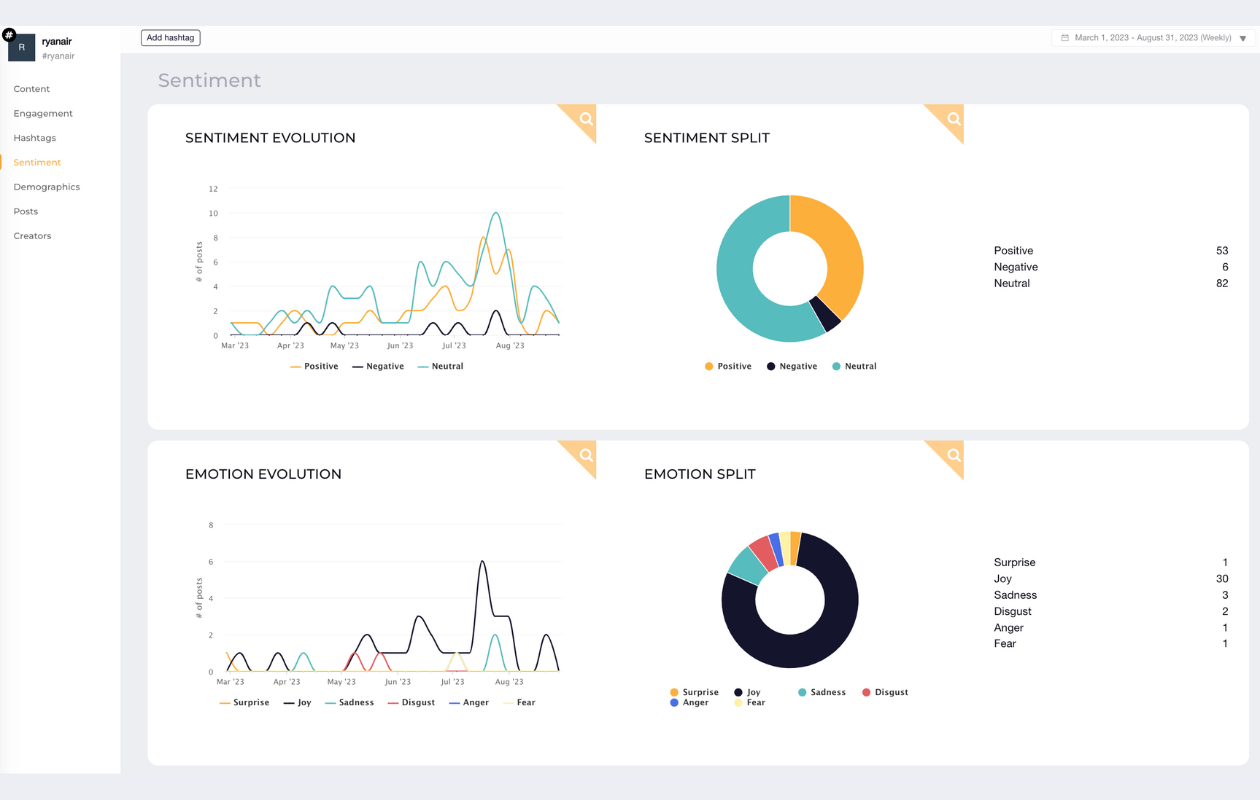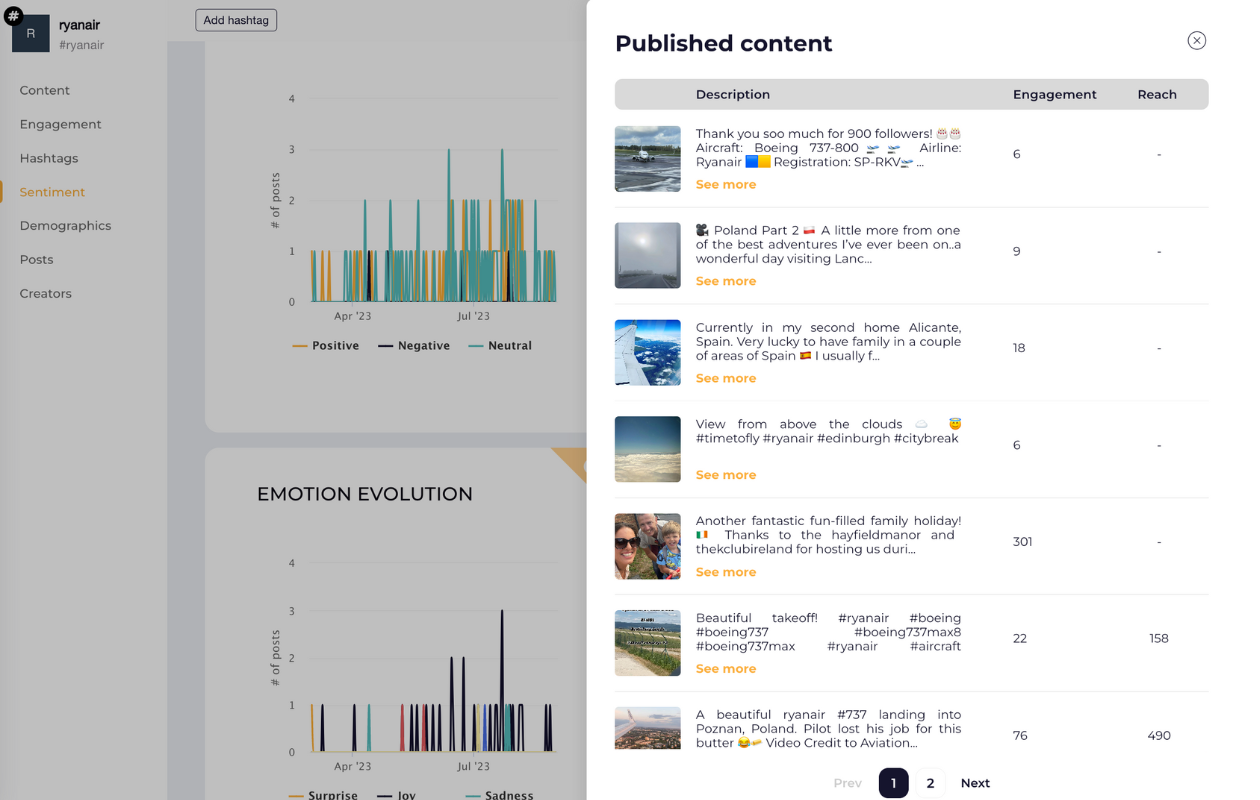The internet can be a goldmine of valuable information that you can use to grow your brand in the right direction. The key is knowing where to look.
By tapping into consumer intelligence, and more precisely into social listening, you can take a proverbial peek behind the scenes and see what’s being said about your brand, industry, niche or topic of interest when you’re not part of the conversation.
To unlock these insights, you first need to filter your search and pick the right social listening metrics to track. Can’t decide which ones? Keep on reading to find out!
How to track key social listening metrics
1. 7 Key Social Listening Metrics to Track
Social listening metrics are KPIs that help you keep an eye on your performance and see how far you’ve come. Metrics used in social listening may be slightly different from the classic social media metrics you’re used to.
It’s useful to group social listening data into clusters and measure them separately to understand how people feel and think about your brand or anything else you’re trying to track.
Mentions
Probably the one metric that’s most often associated with social listening, mentions are a way to see how many people are talking about a specific topic, brand or industry at any given time.
It makes all the sense in the world to track mentions when you’re doing social listening, given that more and more are getting into the habit of tagging brands to get their attention or bring the brand to the public’s attention.
In Socialinsider, you can track mentions for your connected accounts across several platforms - Facebook, Instagram and LinkedIn.

Mentions are also a wonderful tool for measuring brand awareness. Why? Well, tracking brand awareness means tracking the interest generated by your brand. In the age of the internet, when people are interested in something, they like to strike up conversations about it.
If you decide to keep an eye on all conversations that are relevant to your brand, you will begin to understand the size of your brand awareness.
Hashtags volume
Hashtags play a wide variety of roles, the most basic of which is grouping a set of posts around a specific key word or phrase that represents a topic, event or category. (i.e. #travel, #oscars2023, #sportswear).
Tracking hashtags should be an essential part of any regular social media analytics audit, especially since just about any social media platform out there has made hashtags a vital part of their algorithm.
However, social listening is where hashtags really comes into their superpower.
Via hashtags, you can spot popular topics and interests in your audience, measure hashtag campaigns performance, get related topics and understand which concepts are commonly associated with your brand on Instagram.
You can do all that with Socialinsider’s brand new tool: Social Listening.
All you really have to do once you’re logged into the app, is to add a hashtag using the “Add Hashtag” button, then select into from the left sidebar list.
You can then see how many posts feature that hashtag. For extra clarity, we make the distinction between posts coming from content creators/influencers, and individual accounts.

Engagement
Remember when I said sometimes social listening metrics will remind you of those traditional social media metrics? This is one of those times.
It goes without saying that engagement is a very important metric to track - under any and all circumstances - when analyzing your social media performance (and maybe that of your competitors).
As it turns out, it’s a handy metric to look at even when you’re doing social listening.
An image can be worth a thousand words, so I’ll let this screenshot below do all the work and demonstrate why engagement is a valuable social media listening metric.

Total engagement here represents the total number of Instagram likes and comments under all the posts that mention your hashtag. This data is worth considering, because it shows how creators amplify your brand awareness.
Taking the above example, those 2M likes and comments generated by creators could very well be 2M unique people that are now aware of your brand and may in the future be interested in making a purchase from you.
Share of voice
They say comparison is the thief of joy. But there are exceptions. In some cases, you should compare yourself (or your brand, industry etc) to others to have a clear and full picture of where you stand at any given moment.
By calculating your share of voice, you understand how much space your brand is taking up in your target audience’s mind. Basically, you compare your brand’s visibility to that of your competitors.
If you’re looking for a specific formula for share of voice, here it is: your brand mentions / total number of brand mentions (yours + your competitors’) x 100.
Demographics data
If you happen to have a global brand, or at least one with a multi-national reach, it’s worth diving into demographics data to understand more about your audience.
You can get and leverage demographics insights as a part of your regular social media reporting.
However, this type of data also falls into the social listening category because it helps you to extract behavioral insights about your target audience and use them to create more tailored content. As such, you can use it as a complement to your social media analysis.
With Socialinsider, you can easily add demographics data to your social media performance report, by selecting any one of your Facebook, Instagram or LinkedIn connected accounts and scrolling down to the demographics section.
There you can find, depending on the platform you’re focusing on, insights on the geographical distribution of your followers, their age, gender, language spoken, function, seniority and much more.
Here's an example from Facebook analytics:

And one from LinkedIn:

Brand exposure through influencer marketing
If we’ve learned anything from the last few years, it’s that influencer marketing can make your brand awareness skyrocket in no time. Sure, your niche, industry and type of influencers you pick all play a role in how fast you see the results - but the potential is always quite big.
Speaking of picking the right person for the job, Socialinsider’s new Social Listening tool can help you find content creators that are already interested in (and posting about) your topic or niche, or even about your brand.
It’s much easier to pitch your marketing ideas or your brand to someone who’s already invested, don’t you think?
All you have to do to get this data is to add a hashtag into our tool. It can be a specific topic or niche:

Or even a brand (yours or a competitors’):

This list might run pretty long, depending on what you’re looking for. So don’t hesitate to use all the filtering options available, to only show, for instance, creators that have a high number of followers or have shared posts only in English.
Once you've set your sights on a particular creator, you can click “View Details” to learn more about them: most common post types, profile engagement, and more.

Armed with this data, you can start leveraging creators insights to boost your brand's reach and reputation.
Sentiment
One thing you can’t get through regular social media analytics reports is sentiment analysis. Anyone with even a basic level of experience in marketing, particularly brand marketing, should understand the importance of figuring out how people think, feel and choose to talk about a topic or your brand.
Follower count and engagement are valuable metrics to track, but if you want to look deeper, then your audience’s sentiment (and emotions) towards your brand are great social listening metrics to start measuring.
In Socialinsider’s new tool, Social Listening, you can see exactly that.
Taking the example of #ryanair, a brand hashtag, you can see how many people feel positively, negatively or neutrally towards it:

To be even more precise, we break down these 3 types of sentiment into 7 emotions: surprise, joy, sadness, disgust, anger and fear. To see exactly what posts triggered a certain reaction, you can simply click on the corresponding section of the Emotion charts - et voilà!

2. How to start tracking the most important social listening metrics
When analyzing delicate (and to a certain extent subjective) data, like for instance sentiment, you might be tempted to start doing it yourself because you don’t believe a machine can do a better job at reading your audience than you do.
However, with the help of AI and machine learning, which are also integrated into Socialinsider’s new Social Listening tool, this kind of insights are extracted with far more precision than ever before.
So, if you’re wondering how to start tracking your social listening KPIs, we recommend starting with a dedicated tool that will collect the relevant data and organize it in such a way that makes it easy to navigate and interpret.
Final thoughts
In the years to come, machine learning will most likely extend its capabilities, which means that we will be able to collect even more in-depth social listening data and derive more valuable insights from social media analysis.
For now, the 7 social listening metrics listed in this guide are a great starting point in your social listening journey, and should cover most important aspects of this kind of analysis.
Frequently Asked Questions
1. How do you measure social listening?
You can measure social listening by tracking important metrics such as mentions, sentiment, share of voice and more.
2. What are the primary social media channels used for social listening?
According to a recent Britopian study, the top platforms used for social listening are Instagram (51%), Twitter (49%), Facebook (44%), TikTok (31%), and LinkedIn (25%).
3. What business KPIs should you prioritize when doing social listening?
Through social listening, you should prioritize brand awareness, conversions and customer satisfaction.








